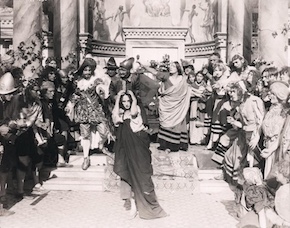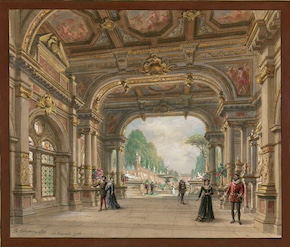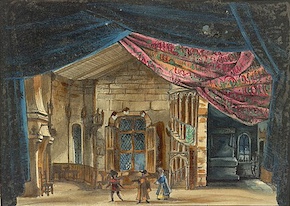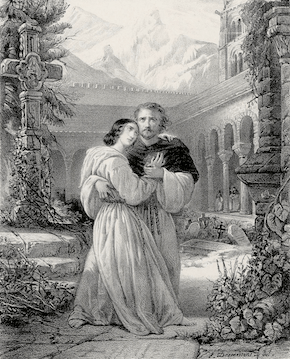
Degas – Ballet Scene from ‘Robert le Diable’
The grand opéra, as understood in 19th century France, is a very specific form that played a major role in the evolution of opera but many of the works composed in that form (essentially exclusively for L’Opéra de Paris, though it goes through several name changes in the period which is a bit confusing) are now not well known and rarely performed. I have been rootling around in this territory for a while now and I thought it might be fun to write a sort of general survey with links to reviews of relevant video and audio recordings.
Set for ‘La vestale’
First, a note about context, terms as they apply here and the scope of this piece. In the decades that this piece covers there were three major opera theatres in Paris (all government subsidised). L’Opéra de Paris was the most prestigious and produced “grand opéra”; always in French. L’Opéra-Comique produced less grand works in the style known as (unsurprisingly) “opéra comique”. Also always in French. The only foreign language house was the Théãtre-Italien which produced Italian language operas mainly by Mozart and (its long time artistic director) Rossini. Grand opéra, by definition, has sung recitatives, almost always involves a ballet (usually in the second act) and is typically divided into five acts. It’s heyday was the late 1820s to somewhere between 1850 and 1870. The 1848 revolution led to somewhat tougher times financially for L’Opéra de Paris which worked against spectacular, expensive productions and then there’s the influence of Wagner which leads to some pretty significant changes so by the time we get to composers like Massenet and Saint-Saens it isn’t real grand opéra in the same sense anymore. I am going to start a little earlier than the late 1820s though because I think there are works that are clearly precursors to the genre proper. I’ll also, for comparison’s sake also touch on opéra comique, as well as what was going on at the Théãtre-Italien. What distinguishes opéra comique in this context is the use of spoken dialogue and, usually, the absence of ballet. It doesn’t, as a literal English translation might suggest, imply it’s a comedy. Usually it’s not. Many of the best known of the 19th century French operas we see today started out as opéras comiques (though we often see them with recitatives which were added later). Somewhat weirdly, nowadays when the grand opéras are performed it’s more usually in an, often inferior, Italian version.

Anna Pavlova in ‘la Muette de Portici’
So to begin at the beginning or a bit before, the departure of Gluck (last major opera Iphigénie en Tauride in 1779) from the Paris/Versailles scene left a pretty large gap to fill. Matters weren’t helped by the upheavals between 1789 and 1815 though, and this in itself says something about opera in France, L’Opéra de Paris continued to operate throughout the period. And it’s really during this period that the precursors of the genre appear. Perhaps the most obvious is Spontini’s La vestale of 1807 (review of audio recording). Essentially all the ingredients are in place here. Another clear pre-cursor is, perhaps oddly, an opéra comique albeit an unusual one. Cherubini’s Médée of 1797 (review of video recording) uses a libretto based on Corneille’s play for both sung and spoken sections and which is rather grander than the usual spoken dialogue. In other respects it’s more grand opera like. Both these works exist in Italian versions which are usually performed today as if they belong to the late 19th century. It’s really worth hearing them as originally intended.

Chaperon – ‘Les Huguenots’
Then there’s Rossini’s last opera, and arguably his greatest; Guillaume Tell of 1829 (reviews of video recordings; London and Pesaro). At this point all the elements that would be crucial are in place including requiring large numbers of singers of very high quality. Curiously, Rossini’s other great success French in Paris was Le comte Ory (1828) (three video reviews on the video review page) which was also written for L’Opéra de Paris but doesn’t really fit the grand opéra formula. He also wrote both serious and comic operas in Italian for the Théãtre-Italien. Also in 1828 another composer better known for his opéras comique, Auber, produced another of the major precursors; La muette de Portici.

Set for Act 2 of ‘La juive’
So we come to the period which is dominated by composers living in Paris plus the temporary stays of pretty much anybody who wanted to make a name for himself (and more money than in Italy or the German speaking lands). I think the dominant name in this period is Meyerbeer and it’s his Robert le Diable of 1831 (review of audio recording) which is generally credited as being the first true grand opéra. Everything is there; five acts, ballet, large orchestra, fiendishly difficult roles, and it also, unusually for the time, had specially designed sets and costumes and was the first opera where gas lighting was used in the Paris Opera. It’s also really rather impressive. It was followed by Les Huguenots in 1836, La prophète in 1949, L’Africaine in 1865 and many others. It’s a measure of the success of Robert that it played in (somewhat bastardised) English translation in London within a year and (in French) in New Orleans not much after. Halévy’s La juive (1835) is another opera from this period much admired at the time and was followed by La reine de Chypre (1841) and Charles VI (1843) Good modern video recordings of any of these operas are really hard to find but there’s a good, if somewhat dated, recording from the Deutsche Oper Berlin of Die Huguenotten (yes, auf Deutsch).

Gilbert Duprez and Rosina Stolz in ‘La favorite’
Alongside Paris based composers notable visitors included Donizetti with La favorite in 1840 (video review), Les martyrs, also 1840 and Dom Sébastien in 1843 though Donizetti’s most lasting hit in Paris was La fille du regiment (video review) written for the Opéra-Comique also in 1840. Verdi had a complicated relationship with Paris. His Jérusalem of 1847 was a reworking of I Lombardi alla prima crociata while his Les vêpres siciliennes of 1855 proved more popular in its Italian version. Verdi did make a late, significant addition to the canon with Don Carlos of 1867 which exists in a baffling variety of versions in both French and Italian. Here’s a video recording review of what is probably close to the original French version. Wagner famously flopped in Paris with an attempt to adapt Tannhäuser for French taste. He made the mistake of putting the ballet in the first act when the toffs were still at the dinner table.
One thing perhaps worthy of note is how many of the works now seen as classic French 19th century operas started out as opéra comique and were later rewritten with sung recitative. Many of these operas are much more often performed than the grand opéras. Gounod’s Faust of 1859 started life as an opéra comique and didn’t hit the L’Opéra de Paris stage as a grand opéra until 1869. The most popular French opera today, by far, Bizet’s Carmen also began life in 1875 at the Opéra-Comique though by this period grand opéra, as understood a few decades earlier was very much in decline and the grander works for the French stage, such as those by Massenet and Saint-Saens seem rather to belong to a different genre. Just as the lighter fare from the opéra comique tradition was morphing into what we think of today as operetta.
The Théãtre-Italien existed in something of a separate world. Besides Mozart and Rossini it featured works that had premiered in Italy as well as works written especially for it; La gazza ladra and Il barbiere di Siviglia for example, and even the occasional work written by a French composer. An example of this would be Louise Bertin’s Fausto (CD review) of 1831 (a great year for devils). But what made it so separate was that their wasn’t much overlap between the audiences. L’Opéra was the establishment house, also much frequented by young bucks looking for a mistress from the corps de ballet. L’Opéra-Comique was a more bourgeois family oriented place and the Théâtre-Italien was a bastion of ultra-reactionaries; the pro Bourbon and ultra montane Catholic old aristocracy being much to the fore, which tended to reinforce a certain stylistic conservatism in the programming at a time when quite revolutionary changes were happening in the other houses.
The business of what opera companies programme is a complex one but I’m pretty sure most regular opera goers would willingly give up a few performances of the “top twenty” in favour of less often seen fare. Obviously there are multiple candidates for categories of under performed works that could be seen more often. Contemporary opera and 20th century classics come to mind immediately but I think there’s a case for taking a look at what was happening in Paris in the mid 19th century. If grand opéra were to be given the same sort of attention that the second half of the 20th century gave to reviving the baroque repertory I think a lot of people would be pleasantly surprised.
